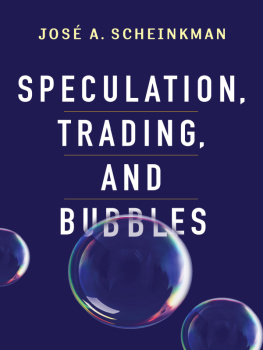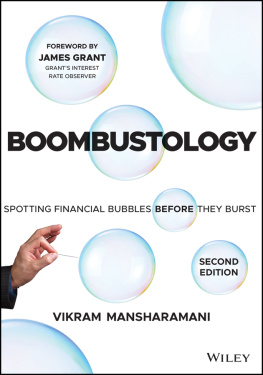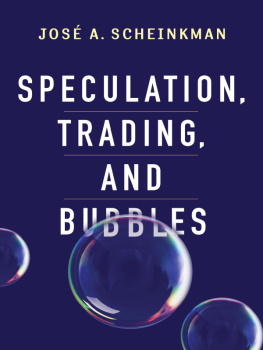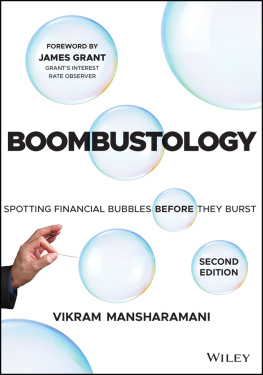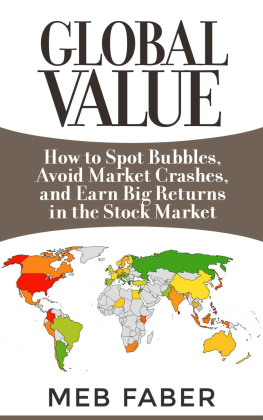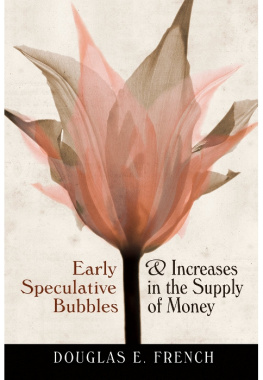BUBBLES AND CRASHES
The Boom and Bust of Technological Innovation
Brent Goldfarb and David A. Kirsch
STANFORD UNIVERSITY PRESS
Stanford, California
Stanford University Press
Stanford, California
2019 by the Board of Trustees of the Leland Stanford Junior University.
All rights reserved.
No part of this book may be reproduced or transmitted in any form or by any means, electronic or mechanical, including photocopying and recording, or in any information storage or retrieval system without the prior written permission of Stanford University Press.
Printed in the United States of America on acid-free, archival-quality paper
Library of Congress Cataloging-in-Publication Data
Names: Goldfarb, Brent, author. | Kirsch, David A., author.
Title: Bubbles and crashes : the boom and bust of technological innovation / Brent Goldfarb and David A. Kirsch.
Description: Stanford, California : Stanford University Press, 2019. | Includes bibliographical references and index.
Identifiers: LCCN 2018037966 (print) | LCCN 2018040063 (e-book) | ISBN 9781503607934 (e-book) | ISBN 9780804793834 (cloth : alk. paper)
Subjects: LCSH: Technological innovationsEconomic aspects. | Business cycles.
Classification: LCC HC79.T4 (e-book) | LCC HC79.T4 G645 2019 (print) | DDC 338/.064dc23
LC record available at https://lccn.loc.gov/2018037966
Typeset by Newgen in 11.25/16 Baskerville
Cover design: Rob Ehle
Cover image: iStock | dkidpix
Mom and Dad, thanks for always cheering me on throughout the many years. Elena and Nathaniel, your brightness keeps me going. Beth, nothing would be possible without your endless love, patience, and support. 17.BDG
Jacob and Isabel, thank you for your company on this and so many journeys. Andrea, I look forward to keeping you company when they have left the nest. Dad, I miss you.DAK
CONTENTS
ACKNOWLEDGMENTS
It pains us to write that this book took many years to complete. It was always a big endeavor, one that grew bigger the deeper and longer we dug. During this time, there has been a long parade of excellent and dedicated students who have assisted us with our research. It would not have been possible to complete this project without early assistance of Pablo Slutzky, Heidi Nalley and Haley Nalley, Fardad Golshany, Jen Fortini, Ami Trivedi, Dana Haimovitz, Aayushi Shah, Dillon Fletcher, Pierre Souchet, Candice Ho, Mahum Hussain, Mary Nguyen, Solen Kebede, Nafeez Amin, Stanley Portillo, Liana Alvarez, Brian Zimmerman, Sanil Shah, and Devika Raj. We also called upon several of our outstanding doctoral students. Robert Vesco helped organize the digitization of the stock prices from the curb market; Liyue Yan and Sandeep Pillai were instrumental at critical moments, oftentimes putting aside their own work to finish this task or the other. Without complaint! The care these students put into this project helped make it a reality. Our local administrative team kept us organized: thank you, Barbara Chipman, Tina Marie Rollason, Kristine Maenpaa, and Mary Crowe.
We received constructive comments from seminar participants at multiple universities, including the University of Wisconsin, the Wharton School at the University of Pennsylvania, Tsinghua University, Hong Kong Polytechnic, UCLA, UC Berkeley, Rutgers, the University of Toronto, London Business School, Ivey Business School, New York University, Universidad de los Andes in Buenos Aires, Boston University, and the University of Chicago. Avi Goldfarb (no relation), Dan Gordon, Jerry Hoberg, Sarah Kaplan, David Kressler, Chris Rider, John Riley, Melissa Schilling, Amanda Sharkey, David Sicilia, Ezra Zuckerman, and four anonymous Stanford University Press reviewers provided invaluable specific feedback. Ajay Agarwal, Ashish Arora, Iain Coburn, Gary Dushnitsky, Daniel Friel, Javier Garcia Sanchez, Naomi Lamoreaux, Dan Raff, Violina Rindova, Zur Shapira, Wes Sine, Scott Stern, Alex Triantis, Roberto Veloso, Marc Ventresca, Dan Wadhwani, and Mark Zbaracki provided encouragement and helped us avoid many pitfalls that were obvious to them, less so to us.
Particular thanks are due to Richard Rumelt (David) and Nathan Rosenberg (Brent) for their guidance and inspiration. Thank you, Rajshree Agarwal, Christine Beckman, Serguey Braguinsky, Wilbur Chung, Christian Deszo, Waverly Ding, Anil Gupta, Rachelle Sampson, Evan Starr, and David Waguespack for creating and sustaining the generative scholarly community we cherish.
Victor Reinoso came up with the title, aided by the crowd. The Reinoso-Nicolet clan has been supportive throughout.
We have been working on this book long enough that we have inevitably failed to mention someone who provided a useful suggestion, comment, or criticism. Our apologies for this oversight.
We also thank the editorial and production staff at Stanford University Press. When we began this project, we did not know how to write a book such as this. Margo Fleming made it possible. She believed in the book, scolded us when necessary, and without question, upped our game.
We are grateful for financial support from the Smith School (across multiple administrations), the National Science Foundation, the Ding-man Center for Entrepreneurship, and the Richard M. Schulze Family Foundation.
No work is perfect. With regard to all remaining problems in the book, empirical, theoretical, or interpretive, the buck stops with us.
College Park, Maryland June 2018
INTRODUCTION
WERE LOSING MONEY FAST ON PURPOSE, to build our brand, Toby Lenk, chief executive officer of eToys.com, proudly proclaimed. Lenk claimed that revenues were increasing an astounding 40% monthly. While most consumer purchases were still made in buildings called stores, in Toby Lenks world, the new economy had arrived. It was February 2000 and eToys was trading at $86 a share, implying an enterprise valuation of $7.7B, 35% more than bricks-and-mortar industry leader Toys R Us. Lenk believed he understood: the internet was changing the business world; traditional retailers would soon be a thing of the past; we would soon be buying groceries, or at least toys, in our underwear. The new economy was inevitable.
This was an astounding proposition given that in 1999 eToys revenues were $30 million. In 1999, Toys R Us took in $30 million in a single day. Not to mention, Toys R Us was profitable, earning $376 million that year, with a respectable, if not particularly remarkable, margin of 6.2%.
The key to e-commerce was to buy high and sell low, in order to generate volume. With volume, costs would decline and profits would ensue. The revenue growth of eToys was extraordinary. These revenues came from eyeballs, or website traffic. Investors fit this fact into a narrative that justified losses to attract this traffic: get big fast. Build it, and they will come, costs will drop, and profits will follow! Get big fast was a narrative shared by the entire dot-com sector.
Meanwhile, Fortune magazine reporter (and later TechCrunch editor) Erick Schonfeld, was struggling with a different question: How much is a customer worth? In the heady days before costs had dropped to support profits, it was all guesswork. For example, in February 2000, a few weeks before the dot-com crash, a Yahoo! customer was valued at three times the value of an Amazon customer. To make sense of this, investors came up with stories to justify stock market valuations. The margins of Yahoo! would be higher than Amazons because online advertising is not as competitive as retail. And while pricing power had proved considerably stronger in advertising than in retail, Yahoo! was a long way from winning the online advertising space (if you dont believe us, just Yahoo! it).



